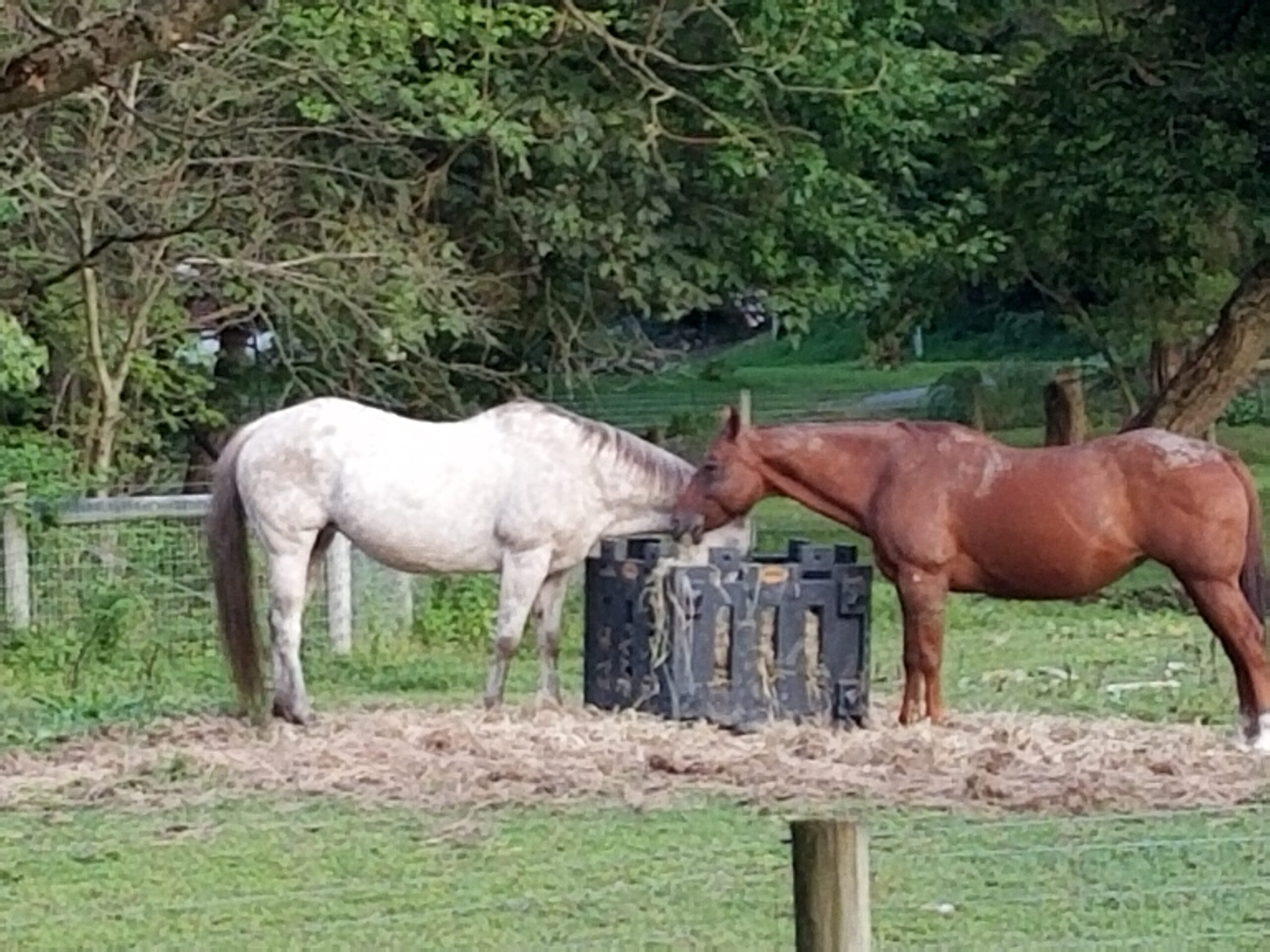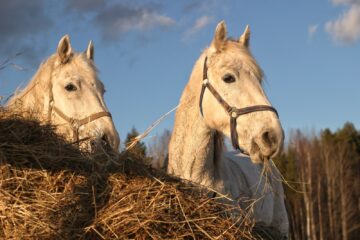Hay Feeding for “Easy” Keepers

Owning a couple of easy keepers myself I am quite familiar with the different strategies of feeding hay to these most difficult of all horses to keep. I thought that I would share them with you.
The Big Picture of Feeding Hay to Easy Keepers
In order to understand the theory behind each of the strategies we must first look at what our ultimate goal is for the process.
We should all know the importance of forage in our horse’s diet. Forage is what a horse evolved to thrive on so it should make up the majority of the horse’s diet.
Easy peasy, buy a big hay feeder, plunk it in the pasture, fill it with lovely hay and forget about it, the horses are satisfied and healthy. Oh, if only it were that simple.
The very first solution owners look to is to restrict the amount of hay for their easy keepers. There’s one big problem with this is that all horses benefit from a full time supply of forage. Keeping the conveyor belt filled with fiber and the system producing saliva to buffer stomach acids are key components for a healthy horse.
The real goal we should be shooting for is to CONTROL the CALORIC intake of our easy keepers. Meaning we don’t necessarily want to restrict hay consumption but more so calorie consumption.
Let’s take a look at some ideas to consider.
Find Low Calorie Hay
I have posted a few articles on hay for horses discussing the different types of hay available and the things that make them different so I’ll not be going into detail here.
Without a hay analysis it is difficult to say how much digestible energy is in a particular hay but if we go by the averages we can assume the following statements to be true most of the time.
Grass hay will have fewer calories than legume hay like alfalfa. Clover is also a legume so if you have grass hay with a large amount of clover it will have higher calories.
Mature first cutting grass hay will have fewer calories than earlier first cutting or second and third cuttings.
When hay shopping for easy keepers look for the last first cutting you can find. Around my area I typically look for hay mowed during the first two weeks of July.
Slow the Rate of Consumption
Sometimes just feeding low cal hay will be enough to maintain a healthy weight on your horses. Other times you will still need to control the rate of consumption to help maintain a healthy weight.
Slow Feed Systems
There are many different slow feed systems for hay available. Some of them slow the rate for a bulk hay feeder or round bales while others are simple nets to stuff with some hay and hang in a convenient spot.
Pick your favorite system that will meet the needs of your horses as well as your schedule and put it to use.
“Busy Hay”
You can also use the hay itself as a slow feed system.
If you are buying mature first cutting grass hay not only will it be low in calories but it will also contain a considerable amount of heavy stalks that are almost straw.
We call this “busy hay” because a horse will have to negotiate around the heavier stalks to find the softer leaves. Many nutritionists caution against the use of “busy hay” because overall it has low digestibility and can cause gastric issues and even colic.
When fed properly “busy hay” is an easy solution to use alone or along with other slow feed systems. The proper method of feeding “busy hay” is to simply feed much more of it than softer more palatable hay.
“Busy hay” is the only type of hay I feed to my easy keepers and I feed about 25% more than I would of a better hay. For example if my 1,000 pound horse should have 18 pounds of hay daily I will feed around 20 to 25 pounds. This ensures that the horses will be able to find sufficient palatable hay to meet their dietary needs.
When feeding this type of hay in their stalls I make up for the “waste” by using the stalkier material as bedding since it is virtually straw.
Soaking Hay
Soaking hay for thirty minutes in cold water and pouring off the water will drop the calories in the hay by 15% to 20%.
Soaking hay is a time killer, messy, heavy and in the winter ranges from inconvenient to virtually impossible. I only suggest soaking hay when dealing with a severe case of obesity or a horse experiencing metabolic laminitis.
Feeding Intervals
If you have the luxury of setting your own barn schedule you can offer hay at various intervals. While it is best for horses to have full time access to hay, having a gap of two or three hours is not the end of time.
If you are feeding busy hay and your target for your horse is 30 pounds you can do the math and spread that out over the course of the day.
Of course, unless you are such a dedicated owner that you will set an alarm for 2 AM to feed hay you will need to come up with a strategy or compromise for overnight hay.
Strategy is the Key
Because all horses and situations are individuals the typical hay feeding solution is a combination of some or all of these methods to reduce calories.
Let’s start with the most challenging of all situations.
Mixed Herds
Feeding all easy keepers or all hard keepers is simple. It’s when we put them all together that trouble starts.
In a perfect world we could have a field for easy keepers and a field for the rest of them but keeping horses is never perfect. There’s alway one or two that refuse to cooperate. Laurel must be with Hardy otherwise it’s bedlam.
The only way to work this out is that at some point for some length of time the horses must be separated for an extended period like turn in.
During turn out the easy keepers will have access to full time hay but during turn in they will be restricted by a slow feed bag.
Another option is to use slow feed systems for everyone to accommodate the easy keepers and provide additional concentrated feed or forage replacement to the hard keepers when they are turned in.
Turn In is Your Friend
Turn in can make a big difference when managing weight in an easy keeper because slow feed systems are most effective when we can keep an individual horse away from access to the free choice hay of the rest of the herd.
In my case my mares will gain weight over the winter since I am quite liberal with access to free choice hay to help keep them warm and occupied. Come springtime they are already a bit on the heavy side and will really start to gain as the weather eases.
The other challenge I have is probably shared by most owners and that is the “hay bully”. If hay is limited my sorrel will keep her pasture mate from the hay and eat both shares. This mare also wants nothing to do with heat and bugs so fairly early in the season she will decide that her stall is the best place to be anyway.
Beginning in early May she and her BFF are locked in their stalls and the sorrel gets about 4 pounds of hay in a slow feed bag with very small openings at 6 AM. At about 1 PM she gets another 4 pounds. Of course at night she has free access to hay.
Since most owners do not have the luxury of a flexible schedule or they are boarding I would stuff a slow feed bag with about 8 pounds and toss an additional flake of free choice on the floor.
My Example
I currently feed three easy keepers and a thoroughbred and I use a combination of the methods listed above.
The thoroughbred would easily maintain weight if she had access to good, high calorie forage. Since she is outnumbered by the Quarter Horses she is on the diet hay and I supplement her with five pounds of concentrated feed daily.
As I mentioned earlier I shop for late season first cutting grass hay for my herd. It is the busiest of busy hay as most goats would turn their noses up at it. The hay is clean and weed free but there are quite a bit of thick stalks in it.
During the cooler weather I will feed about 30 pounds for each horse during a 24 hour period. I will space this out at 5 pounds at 6 AM, 5 pounds at 12 PM and 20 pounds at 6 PM. They will usually finish their 6 AM hay by about 10 AM so they have a two hour window with no hay but they will pick at the stalky stuff and whatever nubs they find around the pasture.
My herd has access to their stalls as they choose so I also hang a slow feed bag stuffed full which averages about 8 pounds of hay. The small holes coupled with the coarse hay means that they have to work for it.
If they run out of hay during the day and are feeling hungry they can go into their stall and pick at the hay in the slow feeder. Overnight I top up their feed bags.
Get Creative
The key to forage strategies for weight management is to be creative when combining feeding methods. I have offered an idea or two based on my experience but there are many variables and many situations so there are many possible solutions.
Unfortunately there is almost never a perfect solution so just do what you can to work with your particular “easy” keeper!

